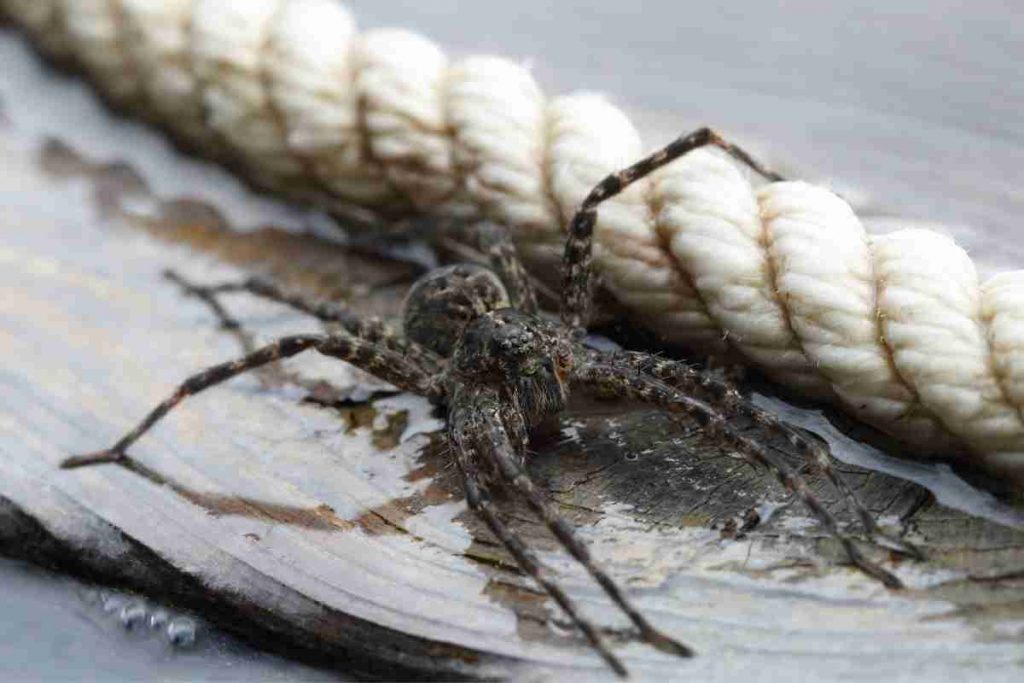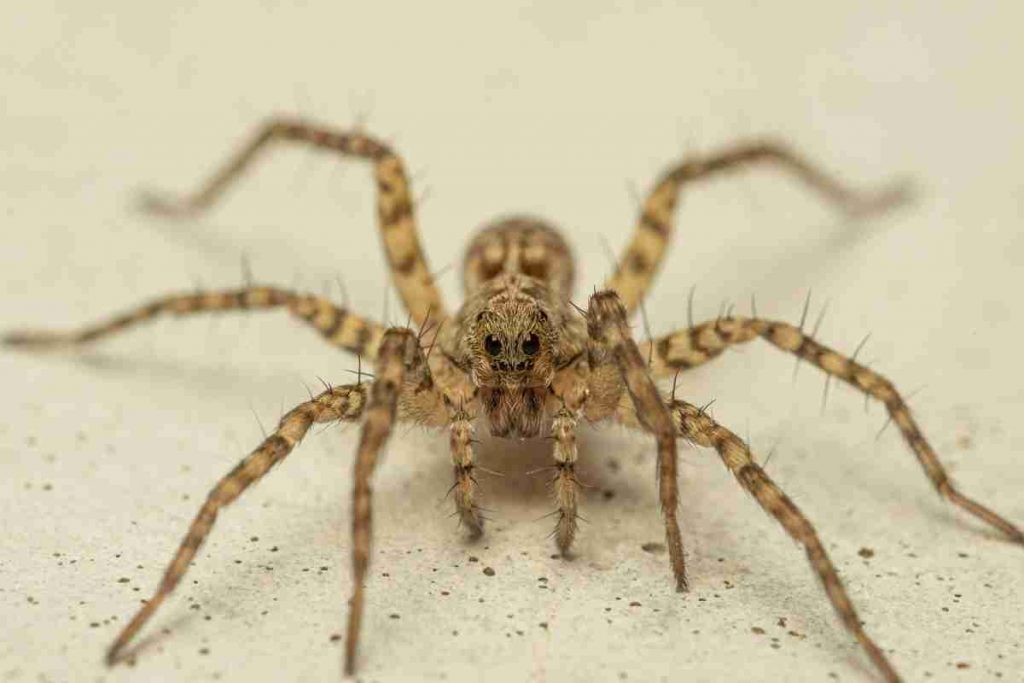Do you know the difference between a fishing spider and a wolf spider? If not, don’t worry! You’re not alone. In fact, both these spiders look so similar that they are often mistaken for one another.
However, there are some key differences between these two spiders that can help you tell them apart. So, below we’ll take a closer look at the physical characteristics, habitat, and behavior of both fishing spiders and wolf spiders.
This way, the next time you see one of these spiders your know exactly which one it is!
What Is A Fishing Spider?
Fishing spiders also known as “Dolomedes” is a large family of spiders, with approximately 100 species all over the world. Some vary in size and colour with the most common being light grey that are usually found near freshwater habitats, and others being dark brown found in woodland areas.
Unfortunately, it’s the grey fishing spiders that get all the attention mainly because of their hunt style.
When grey fishing spiders hunt, they hunt aquatic species, including fish! They are also proficient hunters and will go after other aquatic creatures, such as frogs, and tadpoles.

Some species of fishing spiders can even walk on the surface of the water for short distances. However, when it comes to the dark fishing spider “Dolomedes tenebrosus” they prefer to hunt, and stalk their prey on land. It’s these spiders that are often confused with the wolf spider!
What Is A Wolf Spider?
Wolf spiders are members of the “Lycosidae” family and can be found in nearly every corner of the world. These spiders get their name from their unique hunting style, which is similar to that of a wolf.
Instead, of catching their prey in a web wolf spiders typically hunt using their speed and agility to stalk and capture prey much like the dark fishing spider.
While wolf spiders eat just about anything, their diet consists mainly of insects.
However, some larger species of wolf spiders have been known to prey on small mammals and even reptiles.

Also, wolf spiders do not build webs like other spiders, instead, they build web funnels! that are usually close to the ground, in crevices, or between rocks.
Fishing Spider Vs Wolf Spider Appearance
Although they may look similar these two spiders do have different characteristics. To give you an idea of their appearance below we have provided some key points to look for.
Fishing Spiders Appearance
- Eyes: Distinguishing these spiders is relatively easy based on their eyes. Fishing spiders have eight eyes arranged in two rows, with four on top and four on the bottom, providing them with excellent vision both in and out of the water.
- Size: Another way is by their size! Fishing spiders are usually much larger than wolf spiders with the females growing to 15 to 26 millimeters in length and the males 7 to 13 millimeters
- Legs: Fishing spiders also have longer legs in proportion to their bodies when compared to wolf spiders at approximately 4in and 5 in. This is due mainly to the fact that they need these longer legs to help them move through water and capture prey.
- Color: At first glance fishing spiders look very similar to wolf spiders, however, their color is usually a much lighter almost grey color, with some species being darker on their abdomens with black rings on their legs.
Wolf Spiders Appearance
- Eyes: Wolf spiders have eight eyes too, arranged in three rows with two eyes at the top, two in the middle, and four at the bottom, which is slightly different compared to fishing spiders. This configuration provides them with excellent vision for hunting their prey.
- Size: When it comes to size, wolf spiders are usually smaller than fishing spiders. The average size for a male wolf spider is 6.5 mm long. However, the largest species of wolf spider the “Carolina wolf spider” can grow up to 2.5 cm (1 in) in length.
- Legs: Wolf spiders also have longer legs similar to the fishing spider compared to their body size measuring up to three inches. This helps them move quickly over land and also helps them capture prey.
- Color: When it comes to their color, wolf spiders are usually light brown, with light patterns on their abdomens. Whereas the fishing spider are more dark brown, or light grey depending on the type of species your looking at.
Fishing Spider Vs Wolf Spider Hunting Abilities
Fishing Spiders Hunting Abilities
- Mine Leaping: This hunting technique involves the fishing spider making large leaps at moths and other flying insects that might otherwise evade getting ensnared in the spider’s funnel web.
- Walking On Water: Fishing spiders are recognized for their capacity to walk on water. These spiders possess specialized hair on their legs that enables them to trap air bubbles, providing enough buoyancy to move across the surface of ponds and lakes without sinking.
- Stalking: Fishing spiders will also stalk their prey by hiding and waiting for the right moment to strike. These spiders are able to remain completely still for long periods of time making them very difficult to spot.
- Burrowing: Some fishing spiders will also burrow underground usually near water where they will build a silken-lined tunnel. They will then lie in wait for their prey to walk past before they strike.
Wolf Spiders Hunting Abilities
- Stalking: The wolf spider is a deadly predator that uses ambush tactics to take down its prey. The spider will hide in wait, often for hours at a time, before striking. When their prey comes within range, the spider will pounce, injecting it with venom and paralyzing it.
- Running: Unlike most spiders, which build webs to trap their prey, wolf spiders actively search for food. While in stalking mode if their prey sees them and makes a dash for it, the wolf spider will run down their prey, using their quick speed and agility to capture it.
- Jumping: While not classified as “jumping spiders” technically, wolf spiders can move rapidly and jump significant distances. This capability stems from their powerful legs, employed for catching prey or when they feel threatened.
- Burrowing: Like the fishing spider, wolf spiders will burrow underground. They build their burrows by digging into the ground which has an opening at the top so that the spider can see what is going on around it.
Fishing Spider Vs Wolf Spider Habitat
Fishing Spiders Habitat
As previously mentioned, fishing spiders typically inhabit freshwater environments such as ponds or small streams. These spiders are adept swimmers and are renowned for hunting and capturing their prey in the water.
However, when they are not hunting, fishing spiders will build silken funnel webs and burrows near the water’s edge. They will also use this funnel for catching land prey like insects or reptiles.
Fishing Spiders Ideal Habitat:
- Near lakes
- Woodlands
- Bonds
- Marshes
- Reservoirs
- Rivers
- Streams
Wolf Spiders Habitat
Wolf spiders are predators that hunt their prey, rather than waiting for prey to come to them. Their diet is similar to fishing spiders and consists of insects and other small animals. However, they don’t catch and eat fish.
With that said, Wolf spiders will generally eat whatever they can catch and have been known to eat lizards, frogs, and even small mammals.
Wolf Spider’s Ideal Habitat:
- Gardens
- Grasslands
- Deserts
- Rainforests
- Mountaintops

Fishing Spider Vs Wolf Spider: Diet
Fishing Spiders Diet
Fishing spiders are renowned for consuming small freshwater fish like mosquitofish. However, they also feed on various other animals, such as tadpoles, frogs, salamanders, lizards, and small birds.
Although the majority of their diet consists of live prey, fishing spiders will also consume dead insects found in or near the water.
However, while most spiders use their webs to catch their prey, fishing spiders rely on their quick reflexes to capture their prey. Once the spider has caught its prey, it will wrap it in silk and then inject digestive juices into the prey’s body.
Fishing Spiders Diet:
- Mosquitofish
- Tadpoles
- Frogs
- Salamanders
- Lizards
- Small Birds
Wolf Spiders Diet
Wolf spiders are predators that hunt their prey, rather than waiting for prey to come to them. Their diet is similar to fishing spiders and consists of insects and other small animals. However, they don’t catch and eat fish.
With that said, Wolf spiders will generally eat whatever they can catch and have been known to eat lizards, frogs, and even small mammals.
Wolf Spiders Diet:
- Insects
- Mice
- Frogs
- Flies
- Lizards
Fishing Spider Vs Wolf Spider Life Span
Most spiders have a lifespan of 1-2 years, with some species living for up to 20 years. However, there is significant variation in the lifespan of different spider species.
For example, the average lifespan of a fishing spider is 2 to 3 years. While the average lifespan of a wolf spider is 1 year or less. There are several factors that can affect a spider’s lifespan, including diet, habitat, and predation.
Spiders that live in areas with plentiful food sources tend to have longer lifespans than those that live in areas with scarce food sources.
Similarly, spiders that live in areas with high levels of predation tend to have shorter lifespans than those that live in safe environments. Ultimately, the specific lifespan of a given spider species is determined by a variety of ecological factors.
Which One Is More Dangerous?
When most people see a spider, they react with fear. But not all spiders are aggressive, and in fact, many are harmless to humans. Two of the most common spiders found in North America are the fishing spider and the wolf spider. So, which one is more aggressive?
Although both spiders can deliver a painful bite, neither is considered dangerous to humans. However, the wolf spider is generally more aggressive than the fishing spider.
This is because the wolf spider will run down their prey, using their quick speed and agility to capture it. In contrast, fishing spiders are more passive and will sit and wait for their prey to come to them.
Conclusion
Although both spiders have a lot of similarities as you can see they are some slight differences between them both. At first glance, it will be hard to tell them apart but now you know some of the key features to look out for.
If you have found this article helpful and would like to know more don’t forget to check out our other posts on this site.
Related Article:



